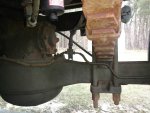URSATDX
Member
- 138
- 19
- 18
- Location
- So Jersey, NJ
Noticed a small leak on the drivers side metal brake line that runs from the junction to the top of the rear wheel
where the bleeder is. I am going to remove the line in hopes of finding something local (Napa?).
When the line is replaced do I bleed the brake system as I have always done in the past on other vehicles?
2 people, one applies the brakes while the other opens the bleeder, repeating, until all air is removed?
Do the air packs have to be bled also?
Thanks in advance.
where the bleeder is. I am going to remove the line in hopes of finding something local (Napa?).
When the line is replaced do I bleed the brake system as I have always done in the past on other vehicles?
2 people, one applies the brakes while the other opens the bleeder, repeating, until all air is removed?
Do the air packs have to be bled also?
Thanks in advance.
Attachments
-
83.8 KB Views: 29





